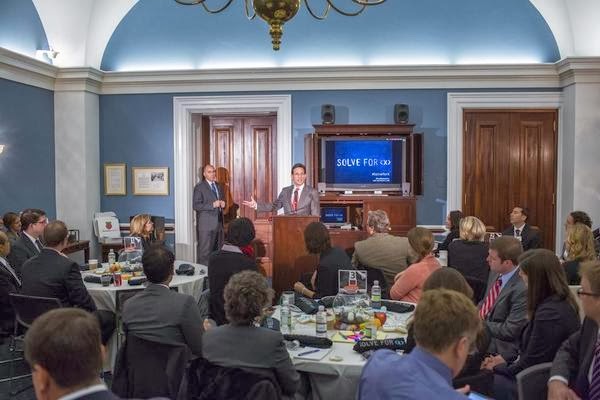Neil Gershenfeld holding up a "Pop FabLab" with Nadya Peek as an example of how 21st century manufacturing won’t just happen in large factories, but out of portable briefcases like this one.
Solve for X is a community of individuals and organizations that work together to accelerate progress on moonshots—and what better group of people to work with than those already thinking about our country’s future? As Susan Molinari, our VP of public policy and government affairs, said at the event: "Policymakers are trying to solve big, intractable problems—and so are engineers. Engineers are tackling challenges that have no answers to date, and so are our policymakers.”
The D.C. event brought together a group of exceptional technologists, entrepreneurs, polymaths-at-large, AAAS fellows, Members of Congress and their staff. Pioneers in their respective fields proposed moonshots in manufacturing, STEM (science, technology, engineering and math) education, and access to natural resources:
- Neil Gershenfeld and Nadya Peek from the MIT Center for Bits and Atoms proposed setting up FabLabs to bring manufacturing back to America—and in a way appropriate to the 21st century
- Theresa Condor from NanoSatisfi proposed an inexpensive way to give all students direct access to personal satellites to conduct their own science experiments and to transform adoption of STEM
- Chris Lewicki from Planetary Resources proposed mining asteroids for natural resources
Majority Leader Eric Cantor (above) said in his opening remarks: “We work in a world of problems, that frankly, any given day somebody could tell you we’ve got a solution for—it’s just about summoning the will to try and actually accomplish it.”
Following the moonshot proposals, we broke into small groups to brainstorm resources, technology and people that could help make the ideas better and happen faster. At Solve for X, brainstorming means two-thirds "yes and"—creating stepping stones to build on an idea—and one-third "yes but—providing critical feedback on blind spots or suggesting alternate implementations.
Democratic Whip Steny Hoyer told us: “You have a psychology of creation. A psychology of ‘what can we imagine?’ And then make it be reality. And that of course is the kind of thinking we need.”
Solve for X co-creators Astro Teller and Megan Smith closed out the event reminding us that moonshots can come from anywhere—people of all ages and places, companies, academia, government, inspired experts, enthusiastic newcomers, even accidental discoveries. So join our 160 moonshot pioneers by submitting your own moonshot video, and contribute to our conversations on Google+ and Twitter—we'd love to hear from you.
Posted by Puneet Ahira, Moonshot Evangelist and Project Lead, Solve for X



Không có nhận xét nào:
Đăng nhận xét